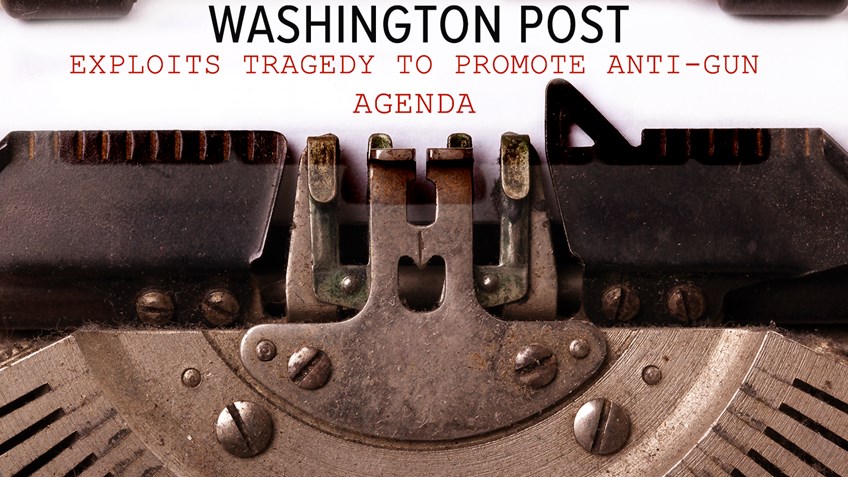We are an online gun store in Helena, MT. We offer a good selection of firearms, ammo & accessories at competitive prices. We also transfer firearms & charge $20 per transfer. We also transfer NFA firearms and charge $75 per transfer. Read more...
Ahead of Election, Washington Post Resorts to Fake News to Politicize Tragedy

On Monday, the Washington Post published an editorial about last Saturday’s heinous crime at the Tree of Life Synagogue in Pittsburgh. The piece was titled “We can stop this American carnage.” True to form, the Post blamed the event not on the actions of a hateful and manifestly evil individual but on a supposed need for more federal gun control.
The newspaper’s editorial board is certainly entitled to that opinion, wrong though it is. What they are not entitled to do by any decent standard of professionalism or integrity is to spread demonstrably false and misleading information in a fraudulent attempt to persuade readers.
Put another way, the Washington Post is propagating fake news to politicize tragedy and to encourage “voters … to send their own message” in next week’s midterm elections by voting for anti-gun candidates.
Let’s start with the headline itself, particularly the notion that “[w]e can stop this … .” This suggests that enlightened thinkers already know how to “stop” mass shootings in the U.S. and that the failure to do so merely reflects a lack of action or will by those who hold the keys to implementing the solutions.
In this case, the Washington Post blames Congress, which it faults for falling to “ban assault weapons and enact other common-sense measures.” What those “other” measures are, the Post does not specify.
No serious person, however, believes that enacting any one, two, three, or however many laws will actually “stop” crime or any particular type of crime. Crime is a complex problem that arises from a variety of factors.
The Federal Bureau of Investigation (FBI) annually publishes detailed information about different types of crime in the United States. In doing so, however, the Bureau includes caveats about the limits of, and legitimate inferences that can be drawn from, the information.
A 2011 FBI publication on hate crimes, for example, warns against using its data to compile simplistic rankings and goes on to expound upon variables that contribute to crime generally.
In particular, it states, “Historically, the causes and origins of crime have been the subjects of investigation by many disciplines,” and then goes on to list “factors that are known to affect the volume and type of crime occurring from place to place … .” None of the 13 listed factors references any specific type of law, much less any gun control law, as a variable in the presence or absence of any type of crime.
That’s not to say that laws themselves cannot influence behavior or other factors that the FBI does identify, such as “[p]opulation density and degree of urbanization” or “[m]odes of transportation and highway system.” Rather, the point is that laws are at most one part of a complex puzzle, and the dynamics that lead to the success of a law or other intervention in one jurisdiction (e.g. climate, per the FBI) might not have the same effect elsewhere.
This helps explain why a country like Mexico, with gun laws that are far stricter than what most American gun control advocates would admit to supporting, is nevertheless infamous for violent crime, including firearm-related homicide. Closer to home, of course, we have seen recent acts similar to those in Pittsburgh in jurisdictions like Washington, D.C. and California that supposedly have “state of the art” gun control.
In the case of a mass homicide of the sort in Pittsburgh, moreover, the perpetrator typically studies similar crimes –aided by the mass media’s obsessive coverage of them – and plans the event well in advance. Such crimes are more akin to terrorism in their deliberateness and preparation, meaning they are probably even less likely than other crimes to be thwarted by laws supposedly intended to “prevent” them.
The bottom line is that for the Washington Post to suggest America is only a handful of laws short of “stopping” mass shootings is simply untrue. While the country is not helpless in the face of this particular type of evil, gun control is not the magic bullet the Post portrays it to be.
Regarding the efficacy of “assault weapons” bans in particular, the Post is on even thinner ice.
The editorial states, “The previous national ban on assault weapons, enacted by Congress in 1994 but allowed to expire in 2004, showed a decrease in the use of assault weapons in crime.”
The article provides no support for that statement, because there is no good evidence to back up that claim. Instead, it links to one of its earlier articles that cites multiple studies that fail to find any crime reduction benefits from the failed federal “assault weapons” ban. That earlier article, a much more nuanced discussion of the topic, does more to refute the Post’s editorial than to support it.
Linking to a New York Times article from Oct. 2017, the Post editorial states, “Gun policy experts asked by the New York Times to rate the effectiveness of policy changes to prevent mass shootings gave their highest ratings to a ban on assault weapons and high-capacity magazines.”
Incredibly, the editorial again mischaracterizes its own source. Even taking the Times article at face value, that’s not what it says. Instead, it states, “The most effective [policy], according to our experts, would be restricting gun sales to anyone found guilty of a violent crime.” That article also refutes the overall premise of the Post’s editorial, stating, “Gun violence researchers say that no law can eliminate the risk of mass shootings, which are unpredictable and represent a small minority of gun homicides over all.“
Moreover, the Oct. Times article linked to by the Post itself links to a fuller discussion by the same authors of the same survey that the Times published in Jan. 2017. The Jan. article puts a different gloss on the findings of the “experts” as they relate to “assault weapons” bans. It states:
Bans on assault weapons and large-capacity ammunition magazines, or limitations on ammunition purchases, would have a greater effect on mass shootings than on routine gun violence, according to the survey. Those rules wouldn’t necessarily reduce the number of mass shootings, the experts said, but could lower the death toll when they occur.
So even the underlying source the Post uses to argue that “assault weapons” bans “prevent” mass shootings fails to make that point.
And while it’s certainly preferable that the mass shootings that do occur have lower death tolls, if simply lowering total firearm-related mortality were the point, the Post shouldn’t be focusing on mass shootings at all. The editorial admits they account for a “minority” of firearm-related deaths, but that’s a gross and misleading understatement. Again, taking the Times at face value, the Jan. article states, “mass shootings … make up around 1 percent of gun homicide deaths.”
But the opinions of the Times’s “experts” as they pertain to the effects of “assault weapons” bans should not be taken at face value, because they have not been scientifically validated. Not all research is the same in quality or rigor, and gun control research in particular can often be affected by the bias of researchers.
The RAND Corporation recently undertook a broad review of the science underlying firearm policy. One of the project’s most significant findings was that the vast majority of what passes for “research” on gun policy is not methodologically sound enough to rely upon for any firm conclusions. Indeed, out of the thousands of studies Rand evaluated during the project, only 62 met its criteria for inclusion in its final analysis.
With regard to “assault weapons” and “high capacity” magazines bans, RAND found the only perceptible effect was perhaps a short-term increase in the price for such guns. That in itself does not establish any beneficial crime or mortality reduction effect, however. RAND found the evidence for these bans as it pertains to mass shootings, homicides, and firearm homicides to be “inconclusive.”
Okay, so there really is no quality empirical support for “assault weapons” bans. But what if the public itself nevertheless insists on them? Is the democratic imperative an argument in favor of them?
The Post seems to think so. The editorial claims, “Polls consistently show that a majority of Americans support laws prohibiting assault weapons,” with even 48% of gun owners agreeing with the policy.
For this claim, the Post links to a June 2017 report by the Pew Research Center. According to that report, 68% of adults polled during March and April 2017, including 48% of gun owners, “strongly” or “somewhat” favor “[b]anning assault-style weapons.” Pew also asked the same question during Jan., Feb., and May of 2013, with a highest overall approval response for any of those survey periods of 56%.
But what, exactly, is “an assault-style” weapon? Pew doesn’t provide any guidance, meaning this critical term is left to the imagination of the respondents.
The Gallup polling organization, on the other hand, asks the more specific question, “Are you for or against a law which would make it illegal to manufacture, sell or possess semi-automatic guns, known as assault rifles?” This question makes clear that the proposal applies to much more common semiautomatic rifles, not just machine guns.
According to the Gallup trend line, after peaking at 59% in 2000, support for such a ban has fallen almost continually. There was a brief uptick to 48% support in 2017, a year that saw the deadliest mass shooting in modern American history, but then it dropped to a nearly historic low of 40% in polling conducted in Oct. 2018. Meanwhile, 57% polled by Gallup in Oct. opposed such a ban.
Thus, when the question specifically focuses on semiautomatic rifles like the AR-15, the overall trend since the turn of the Millennium is exactly the opposite of what the Post claims.
We could go on, but we’ll limit ourselves to one more glaring falsehood in the Post editorial, the assertion that “[a]ssault-style weapons … are the weapon of choice of mass murderers … .”
Assuming the term “mass murderer” to mean the perpetrator of the types of crimes mentioned elsewhere in the editorial, this is also false.
Again, this is so even if you take the Washington Post’s own prior reporting at face value. In Oct., the Post reviewed 157 shootings dating back to 1966 in which four or more people were killed by a one or two assailants. Of the 304 guns the Post reports were used in these incidents, roughly 25% were some type of semiautomatic rifle. The report also correctly notes that the perpetrators of these crimes often used more than one type of firearm.
The (virulently antigun) publication Mother Jones keeps a database of mass shooting information dating back to 1982, including information on the firearms involved.
Of the 106 incidents listed, about 7% involved only the use of a firearm described as a semiautomatic rifle or “assault rifle.”
Approximately 26% of the incidents involved such a firearm along with other types of firearms.
Various types of handguns remained the most commonly used firearms in both datasets, which is consistent with the handgun being the most commonly used gun in firearm-related crime generally.
In summary, the most charitable thing that can be said about the Washington Post editorial is that it is incredibly sloppy and misleading. But considering how the editorial’s own links and the Post’s own prior reporting refute the board’s assertions, it is very difficult to grant the editors the benefit of that doubt.
We will leave the resolution of whether the Post is merely sloppy or intentionally dishonest to our readers.
Suffice to say that the Washington Post editorial board shamed itself not only with its opportunistic exploitation of tragedy to promote a political agenda, but by doing so with false, incomplete, and misleading information. Americans trying to educate themselves on matters of national importance, especially as they concern Second Amendment rights, would be well-advised to take the Post’s editorializing with a healthy degree of skepticism.
Source: Click Here






Leave a Comment!
Comments